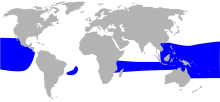Fregata minor
| Great frigatebird | |
|---|---|
 |
|
| Adult male, displaying, with inflated gular sac | |
| Scientific classification | |
| Kingdom: | Animalia |
| Phylum: | Chordata |
| Class: | Aves |
| Order: | Suliformes |
| Family: | Fregatidae |
| Genus: | Fregata |
| Species: | F. minor |
| Binomial name | |
|
Fregata minor (Gmelin, 1789) |
|
 |
|
| Range map | |
| Synonyms | |
|
Pelecanus minor Gmelin 1789 |
|
Pelecanus minor Gmelin 1789
Tachypetes palmerstoni
The great frigatebird (Fregata minor) is a large seabird in the frigatebird family. Major nesting populations are found in the Pacific (including the Galapagos Islands) and Indian Oceans, as well as a population in the South Atlantic.
The great frigatebird is a lightly built, large seabird up to 105 cm long with predominantly black plumage. The species exhibits sexual dimorphism; the female is larger than the adult male and has a white throat and breast, and the male's scapular feathers have a purple-green sheen. In the breeding season, the male is able to distend its striking red gular sac. The species feeds on fish taken in flight from the ocean's surface (mostly flying fish), and indulges in kleptoparasitism less frequently than other frigatebirds. They feed in pelagic waters within 80 km (50 mi) of their breeding colony or roosting areas.
When German naturalist Johann Friedrich Gmelin first described the great frigatebird in 1789, he thought it was a small pelican, and so named it Pelecanus minor. Due to the rules of taxonomy, its species name of minor was retained despite being placed in a separate genus by the Australian ornithologist Gregory Mathews in 1914. This has led to the discrepancy between minor, Latin for "smaller" in contrast with its common name. It is one of five closely related species of frigatebird that make up their own genus (Fregata) and family (Fregatidae). Its closest relative within the group is the Christmas Island frigatebird (F. andrewsi).
...
Wikipedia

